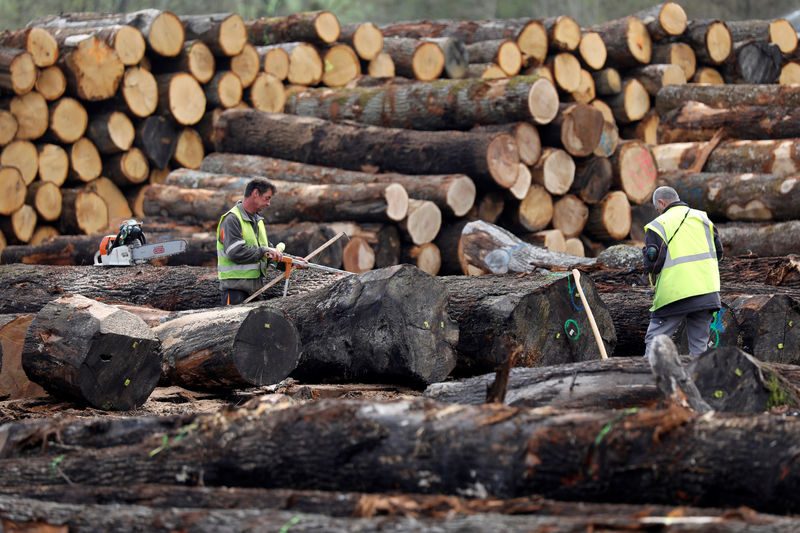(Bloomberg) -- The frenzy sweeping the lumber market will likely keep going through the summer peak of U.S. home building as labor shortages and depleted inventories mean that supplies can’t keep up with skyrocketing demand.
Tightness is acute across the entire timber supply chain. Sawmills have had trouble ramping up fast enough to meet the surge in demand. Meanwhile, trucking delays and worker shortages at lumber yards have added to costs, which are now getting passed on to consumers. Lumber futures have surged more than 60% to record highs this year, and analysts aren’t expecting any relief until late 2021.
That will keep pouring fuel on red-hot home prices, making ownership less affordable for large swathes of the population. Soaring wood costs have already added more than $24,000 to the price of the average new U.S. house, according to National Association of Home Builders. Industry groups and lawmakers have called on the Biden administration to step in and find remedies for the lumber shortage.
“Each part of the supply chain has different issues,” said Brooks Mendell, chief executive officer of forest-supply researcher Forisk Consulting in Georgia. “There is not a sawmill that I have talked to in two years that has all their slots filled.”
This is a big turnaround from just two years ago. In 2019, weak demand prompted a steady stream of output reductions and mill closures from companies including Canfor (TSX:CFP) Corp. and West Fraser Timber Co (NYSE:WFG)., the world’s biggest lumber supplier. That left producers flat footed amid the unexpected demand boom as the pandemic kept people indoors, sparking a wave of do-it-yourself upgrades, full-scale renovations and purchases of bigger homes.
When demand held strong throughout the winter, typically a seasonal lull, mills didn’t have time to replenish their inventories. Now, stockpiles are “extremely lean” as North America heads back into peak building season and lumber prices will stay high “for the foreseeable future,” Devin Stockfish, the CEO of Weyerhaeuser (NYSE:WY) Co., said last month.
Lumber futures have more than tripled since the pandemic started, touching an all-time high of $1,157.50 per 1,000 board feet on Monday.
Cash markets are also blistering. Oriented strand board, used as sheathing for walls and roofs, soared to a record $999 per 1,000 square feet at the end of March, up from $329 in June, according to lumber pricing company Random Lengths.
Across commodities, supply chains are snarled at a time when the economic rebound is driving demand higher. While investors have backed down from some of their price optimism for now, markets with production issues are still moving higher. Coffee is a prime example, with signs that a global deficit is widening. Meanwhile, dwindling rubber supplies are causing headaches for automakers.
For lumber, long-standing labor shortages are limiting efforts to boost inventories in places like the southern U.S., home to half of the country’s production. Many of the industry’s jobs are relatively low paying, require physical labor and can sometimes be dangerous, which keeps people from filling open slots even when unemployment is high.
The number of people working in U.S. sawmills and doing wood preservation is down roughly 30% from 20 years ago, with the number of loggers dropping almost 40%, U.S. Bureau of Labor Statistics data show. While automation has reduced the number of workers required and increased efficiencies, analysts view current employment levels as below demand.
“The chronic labor shortage is a significant piece of the puzzle,” said Paul Jannke, principal of Forest Economic Advisors LLC, a wood product analysis company near Boston. “In the U.S. South, you don’t have the sufficient skilled labor to run all of the new capacity that is needed to meet demand.”
Labor isn’t the only long-term supply issue. Climate change and extreme weather are threatening logging. A plague of tiny mountain pine beetles is getting worse as warmer winters allow the bugs to thrive in more place across the globe. Massive wildfires are an increasing concern for forests along the U.S. and Canadian West Coast. Meanwhile, the timber industry and environmental advocates have also jockeyed over what lands should stay protected.
The beetle infestation in Europe is actually helping to increase U.S. supplies this year, though, since the insects are killing so many trees and boosting logging. U.S. lumber imports will need to grow by about 15% in 2021 to meet the jump in demand, and much of that is expected to come from Europe, Jannke said in a recent presentation.
Home Prices Soar in Frenzied U.S. Market Drained of Supply
Lumber supplies aren’t expected to return to normal until late 2021, after this year’s peak in homebuilding. By then, demand could start to abate. But more importantly, output gains will help rebuild stockpiles. In the U.S. South, record production is expected this year, according to Mendell of Forisk.
And not all companies are facing worker issues. West Fraser said it’s not experiencing any labor-supply challenges at its U.S. sawmills, and major OSB and siding producer Louisiana-Pacific (NYSE:LPX) Corp. also said it’s not seeing labor constraints.
But the shortages are posing a hiring challenge for Sherwood Lumber, a wholesaler based in Melville, New York.
The company typically needs about 50 people to work across eight lumber yards and is currently short of that by as much as 20%, according to Brian Nunes, the director of operations. The positions pay about $3 an hour above minimum wage -- $15 to $20 hour depending on state location.
It’s so hard to find employees that Sherwood is now bumping the usual wages by roughly $1.50 to $2 an hour.
“To not have applicants and not have a labor pool, where you’re struggling to get a single applicant, is very abnormal,” Nunes said. “A labor shortage, compounded with reduced trucking capacity will continue to have an adverse effect on availability in our industry, which will continue to keep lumber prices in this unprecedented range.”
©2021 Bloomberg L.P.
